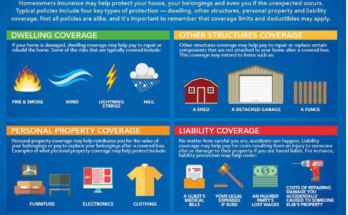Home Insurance vs. Contents Insurance: What’s the Difference?
Understanding the intricacies of insurance can be overwhelming, especially when it comes to distinguishing between different types. Home insurance and contents insurance are two vital components of safeguarding your property and possessions, but they serve distinct purposes. This comprehensive review will delve into the differences between home insurance and contents insurance, highlighting their features, benefits, and drawbacks to help you make informed decisions for your protection.
What is Home Insurance vs. Contents Insurance: What’s the Difference?
Home insurance, also known as homeowners insurance, provides coverage for the physical structure of your home and the attached structures, such as garages and decks. This insurance typically protects against risks such as fire, theft, vandalism, and certain natural disasters.
Contents insurance, on the other hand, focuses on protecting your personal belongings within the home, such as furniture, electronics, clothing, and valuables. While home insurance covers the building itself, contents insurance ensures that your possessions are financially protected.
Coverage Breakdown
| Aspect | Home Insurance | Contents Insurance |
|---|---|---|
| Coverage Type | Structure of the home | Personal belongings |
| Natural Disasters | May cover specific disasters (floods, etc.) | Limited or no coverage for natural disasters |
| Liability Coverage | Yes | Limited or no liability coverage |
| Additional Living Expenses | Typically included | Not applicable |
How Home Insurance vs. Contents Insurance: What’s the Difference? Work
Both home insurance and contents insurance function by providing financial protection against various risks. When you purchase a policy, you pay a premium to the insurer, who agrees to compensate you for losses covered under the policy terms.
- Home Insurance: This policy kicks in when the physical structure of your home is damaged or destroyed. For instance, if a fire damages your house, your home insurance would cover the repair or rebuilding costs, minus any deductibles.
- Contents Insurance: This policy activates when your personal belongings are damaged, stolen, or destroyed. For example, if a thief breaks into your home and steals your electronics, contents insurance would cover the cost to replace those items, again minus any deductibles.
Features of Home Insurance vs. Contents Insurance: What’s the Difference?
Home Insurance Features
- Dwelling Coverage: Protects the physical structure of your home against covered perils.
- Personal Liability Protection: Covers legal fees and medical expenses if someone is injured on your property.
- Additional Living Expenses (ALE): Covers temporary housing and living costs if your home becomes uninhabitable due to a covered event.
- Other Structures Coverage: Protects structures not attached to the home, such as sheds or fences.
Contents Insurance Features
- Personal Property Coverage: Covers loss or damage to personal belongings due to theft, fire, or vandalism.
- Off-Premises Coverage: Often includes protection for belongings that are temporarily away from home.
- Valuable Items Coverage: Allows you to add coverage for high-value items, such as jewelry and art.
- Replacement Cost vs. Actual Cash Value: Policies may differ in whether they cover the replacement cost or the actual cash value of lost items.
Pros of Home Insurance vs. Contents Insurance: What’s the Difference?
| Type | Pros |
|---|---|
| Home Insurance | – Protects your home’s structure – Covers liability costs – May include additional living expenses |
| Contents Insurance | – Protects personal belongings – Often cheaper than home insurance – Flexible coverage options for valuables |
Cons of Home Insurance vs. Contents Insurance: What’s the Difference?
| Type | Cons |
|---|---|
| Home Insurance | – Higher premiums – May have exclusions for certain disasters – Complex policy terms |
| Contents Insurance | – Doesn’t cover the home structure – Limited coverage for high-value items – May require separate policies for special items |
Home Insurance vs. Contents Insurance: What’s the Difference? Alternatives
| Alternatives | Description |
|---|---|
| Renters Insurance | Similar to contents insurance but for renters, covering personal belongings only. |
| Landlord Insurance | Designed for property owners renting their homes, covering the building and some liability. |
| Comprehensive Insurance | Bundles home and contents insurance into one policy for streamlined coverage. |
Conclusion and Verdict: Home Insurance vs. Contents Insurance: What’s the Difference?
In summary, understanding the distinction between home insurance and contents insurance is crucial for anyone looking to protect their home and belongings. While home insurance covers the physical structure and liability, contents insurance focuses on personal property protection. Depending on your living situation and needs, you may benefit from one type of insurance over the other, or a combination of both.
Carefully assess your personal circumstances, the value of your home and possessions, and the potential risks you face. Choosing the right insurance policy will ensure that you have the necessary coverage to safeguard your financial future.
FAQs: Home Insurance vs. Contents Insurance: What’s the Difference?
- Do I need both home and contents insurance?
It depends on your situation. If you own a home, both types are advisable for complete protection. Renters may only need contents insurance. - What happens if I have a claim?
When you file a claim, your insurer will assess the damage, and if approved, compensate you according to your policy terms. - Can I bundle home and contents insurance?
Yes, many insurers offer discounts for bundling both policies, which can save you money. - How do I choose the right insurance policy?
Evaluate your coverage needs, budget, and compare multiple insurance providers to find the best fit for your situation. - What are common misconceptions about home and contents insurance?
Many people believe contents insurance covers their home structure, which is incorrect. It’s crucial to understand that these policies serve different purposes.
This review serves as a comprehensive guide to understanding the differences between home insurance and contents insurance, ensuring you are well-informed to make the best choices for your coverage needs.



